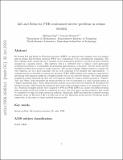Lift and Relax for PDE-Constrained Inverse Problems in Seismic Imaging
Author(s)
Fang, Zhilong; Demanet, Laurent
DownloadAccepted version (3.348Mb)
Open Access Policy
Open Access Policy
Creative Commons Attribution-Noncommercial-Share Alike
Terms of use
Metadata
Show full item recordAbstract
IEEE We present lift and relax for waveform inversion (LRWI), an approach that mitigates the local minima issue in seismic full waveform inversion (FWI) via a combination of two convexification techniques. The first technique (Lift) extends the set of unknown variables to their products, arranged as a moment matrix. This algebraic idea is a celebrated way to replace a hard polynomial optimization problem by a semidefinite programming approximation. Concretely, both the model and the wavefield are lifted from vectors to rank-2 matrices. The second technique (Relax) invites to relax the strict wave-equation constraint--a technique known as wavefield reconstruction inversion (WRI), which introduces wave-equation misfits as a weighted penalty term in the objective function. The relaxed penalty formulation enables balancing the data and wave-equation misfits by tuning a penalty parameter. Together, ``Lift'' and ``Relax'' help reformulate the inverse problem as a set of constraints on a rank-2 moment matrix. Such a lifting strategy permits good data and wave equation fits throughout the inversion process while leaving the numerical rank of the rank-2 moment matrix to be minimized down to one. Moreover, LRWI does not require adjoint wavefield to compute the gradient, which mitigates computational burdens. Numerical examples indicate that starting with a poor initial model, LRWI can conduct successful inversions with a starting frequency that is higher than that required by FWI and WRI.
Date issued
2020Department
Massachusetts Institute of Technology. Department of Mathematics; Massachusetts Institute of Technology. Earth Resources LaboratoryJournal
IEEE Transactions on Geoscience and Remote Sensing
Publisher
Institute of Electrical and Electronics Engineers (IEEE)